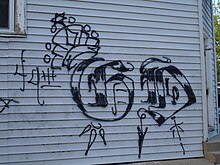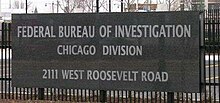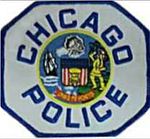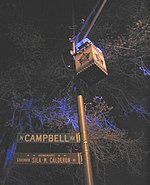Overview
Chicago saw a major rise in violent crime starting in the late 1960s. Murders in the city peaked in 1974, with 970 murders when the city's population was over three million, resulting in a murder rate of around 29 per 100,000, and again in 1992, with 943 murders when the city had fewer than three million people, resulting in a murder rate of 34 murders per 100,000 citizens.
After 1992, the murder count steadily decreased to 415 murders by the mid-2000s, a reduction of over 50 percent. In 2021, there were 804 homicides recorded, [10] representing a murder rate of 29.6 per 100,000. [11]
Violent crime

Chicago experienced major rises in violent crime in the 1920s, in the late 1960s, and in the 2020s. [12] a decline in overall crime in the 2000s, [13] and then a rise in murders in 2016. [14] Murder, rape, and robbery are common violent crimes in the city, and the occurrences of such incidents are documented by the Chicago Police Department and indexed in annual crime reports. [15]
After adopting crime-fighting techniques in 2004 that were recommended by the Los Angeles Police Department and the New York City Police Department, [16] Chicago recorded 448 homicides, the lowest total since 1965. This murder rate of 15.65 per 100,000 population was still above the U.S. average, an average which takes in many small towns and suburbs. [17]
By 2010, Chicago's homicide rate had surpassed that of Los Angeles (16.02 per 100,000), and was more than twice that of New York City (7.0 per 100,000). [18] By the end of 2015, Chicago's homicide rate rose to 18.6 per 100,000. By 2016, Chicago had recorded more homicides and shooting victims than New York City and Los Angeles combined. [19] By the end of 2020, Chicago's homicide rate rose to 28 per 100,000.
Chicago's biggest criminal justice challenges have changed little over the last 50 years, and statistically reside with homicide, armed robbery, gang violence, and aggravated battery.

Murder and shootings
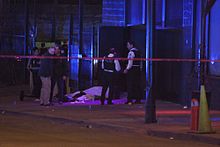
| Year | Chicago population in million | Murder/homicide count | Murder/homicide rate per 100,000 population | Reported murder clearance rate in % |
|---|---|---|---|---|
| 2023 | 2.70 [20] | 617 [21] | 22.85 | |
| 2022 | 2.665 [22] | 695 [23] | 26.07 | |
| 2021 | 2.697 [24] | 800 [25] | 29.66 | 50.00% |
| 2020 | 2.746 [26] | 772 [27] | 28.1 | 45.6% |
| 2019 | 450-506 [27] | 18.26 | 53% | |
| 2018 | 513-567 [28] | 20.71 [29] | ||
| 2017 | ~2.7 [30] | 601-653 [27] | 24.1 | |
| 2016 | 2.725 | 762-784 [31] [32] | 27.7-28 | 21% |
| 2015 | 472-478 [33] | 17.5 | 26% [34] | |
| 2014 | 2.724 | 411 [35] | ||
| 2013 | 414 | 15.22 | ||
| 2012 | 500 | 18.5 | ||
| 2011 | 431 | 15.9 | 34% | |
| 2010 | 2.695 | 432 | 16 | |
| 2009 | 459 | 16.1 | ||
| 2008 | 510 | 18 | ||
| 2007 | 443 | 15.6 | ||
| 2006 | 467 | 16.4 | ||
| 2001 | 22.9 | |||
| 2000 | 2.896 | 22.1 | ||
| 1996 | 796 [36] | |||
| 1992 | 939 | 33.1 [37] | ||
| 1990 | 2.783 | 32.9 | ~70% | |
| 1981 | 877 [38] | 78.4% | ||
| 1980 | 3.005 | 28.7 | ||
| 1974 | 970 [39] | 30.5 [40] | ||
| 1970 | 3.366 | 24 | ||
| 1960 | 3.550 | 10.3 | ||
| 1950 | 3.620 | 7.9 | ||
| 1940 | 3.396 | 7.1 | ||
| 1930 | 3.376 | 14.6 | ||
| 1920 | 2.701 | 10.5 | ||
| 1910 | 2.185 | 9.2 | ||
| 1900 | 1.698 | 6.0 | ||
| 1890 | 1.099 | 7.0 | ||
| 1870 [41] | 0.299 | 2.6 | ||
Former Chicago Police Superintendent Garry McCarthy said a pervasive "no-snitch code" on the street remains the biggest reason more murders aren't being solved in Chicago, adding, "We're not doing well because we're not getting cooperation [...] They don't feel protected when they come forward. They feel that police will throw them under a bus, and they still have to live in the neighborhood." [42] By 2016, Chicago's murder clearance rate had dropped to only 21%, and its detective force had dwindled from 1,151 in 2009 to 863 as of July 2016. [43] [44] Warmer months have significantly higher murder rates, and over 70% of murders take place between 7 pm and 5 am. [45] [46]
In 2011, 83% of murders involved a firearm, and 6.4% were the result of a stabbing. 10% of murders in 2011 were the result of an armed robbery and at least 60% were gang or gang narcotics altercations. Over 40% of victims and 60% of offenders were between the ages of 17 and 25. 90.1% of victims were male. 75.3% of victims and 70.5% of offenders were African American, 18.9% were Hispanic (20.3% of offenders), and whites were 5.6% of victims (3.5% of offenders). [45]
Murder rates in Chicago vary greatly depending on the neighborhood in question. Many of the predominantly African American neighborhoods on the South Side are impoverished, lack educational resources and noted for high levels of street gang activity. [47] The neighborhoods of Englewood on the South Side, and Austin on the West side, for example, have homicide rates that are ten times higher than other parts of the city. [48]
Violence in these neighborhoods has had a detrimental impact on the academic performance of children in schools, as well as a higher financial burden for school districts in need of counselors, social workers, and psychiatrists to help children cope with the violence. [49] In 2014, Chicago Public Schools adopted the "Safe Passage Route" program to place unarmed volunteers, police officers and firefighters along designated walking routes to provide security for children en route to school. [50] From 2010 to 2014, 114 school children were murdered in Chicago. [51]
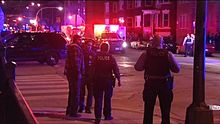
Chicago Police Superintendent Garry McCarthy was terminated by Rahm Emanuel following the fall out from the shooting of Laquan McDonald. [52]
A gunshot wound to the body's center of mass can quickly prove fatal without immediate medical attention due to blood loss and internal injuries. [53] In September 2015, University of Chicago Medicine and Sinai Health Systems announced a joint $40 million venture to convert Holy Cross Hospital into a Level 1 trauma center on the South side, making some of Chicago's most violent neighborhoods less than five miles from high-quality care. [54] Non-fatal gunshot victims in Chicago had an overall rate of occurrence of 46.5 per 100,000 from 2006 to 2012, with a demographic breakdown of 1.62 per 100,000 for whites; 28.72 for Hispanics, and 112.83 for blacks. [55] It is estimated that the medical expenses associated with gun violence costs the city of Chicago $2.5 billion a year. [56] [57]
Chicago has been criticized for comparatively light sentencing guidelines for those found illegally in possession of a firearm. Most people convicted of illegal gun possession receive the minimum sentence, one year, a Chicago Sun-Times analysis found, and serve less than half of the sentence because of time for good behavior and pre-trial confinement. The minimum sentence for felons found in possession of a firearm is two years. Those charged with simple gun possession had an average of four prior arrests. Felons charged with prior gun related crimes will be faced with stricter sentencing as of a new bill proposed in 2017. Those charged with gun possession by a felon had an average of ten prior arrests. [58]
In September 2015, an area and neighborhood of Chicago, West Garfield Park, was named "America's mass shooting capital", citing 18 occasions in 2015 in which at least four people were shot in a single incident. [59] In 2016, the number of murders soared to 769. [14] August 2016 marked the most violent month Chicago had recorded in over two decades with 92 murders, included the murder of Nykea Aldridge, cousin of NBA star Dwyane Wade. [19] [60] Chicago's 2016 murder and shooting surge has attracted national media attention from CNN, The New York Times , USA Today , Time magazine and PBS. [61] [62] [63] [64] [65] Filmmaker Spike Lee's 2015 release, Chi-Raq , highlights Chicago's gun violence using a narrative inspired by the Greek comedy Lysistrata . [66]
In 2017, the number of homicides fell to 653, [14] dropping to 561 in 2018 [67] and 492 in 2019. Chicago's deadliest day since reliable digital records began in 1991, was on May 31, 2020, with 18 murders committed. That day was part of a three-day weekend that had 85 shootings, and 24 murders, the all-time highest number killed on a Chicago weekend. [68] Reports indicate that the victims were of various ages and occupations, but mostly black. The violence was framed by the George Floyd protests, but researchers said it was unheard of and unable to be contextualized. The city's second-deadliest day had 13 murders, and occurred in 1991 shortly after digital records were introduced. There is no deadlier day recorded in the past 60 years, but records prior to 1991 may be unreliable. [69]
Homicide statistics | |||||||||||||||||||||||||||||||||||||||||||||||||||||||||||||||||
|---|---|---|---|---|---|---|---|---|---|---|---|---|---|---|---|---|---|---|---|---|---|---|---|---|---|---|---|---|---|---|---|---|---|---|---|---|---|---|---|---|---|---|---|---|---|---|---|---|---|---|---|---|---|---|---|---|---|---|---|---|---|---|---|---|---|
|
